Stanmore College: Exploring Reflex Arc, Hormones & Reproduction
VerifiedAdded on 2023/06/13
|10
|2015
|125
Homework Assignment
AI Summary
This assignment delves into key aspects of human biology, focusing on the reflex arc, endocrine system, and reproductive systems. It identifies and describes the five components of the reflex arc: receptor, sensory neuron, interneuron, motor neuron, and effector. The assignment also outlines the major glands of the endocrine system, including the pineal, pituitary, thyroid, parathyroid, adrenal, reproductive glands, and pancreas, detailing the hormones they produce and their functions. Furthermore, it explains the roles of both the nervous and endocrine systems in controlling the body, highlighting their interactions and the importance of maintaining homeostasis. Finally, the assignment describes the male and female reproductive systems, labeling their key components and outlining their functions. This comprehensive overview provides a solid understanding of these essential biological systems.
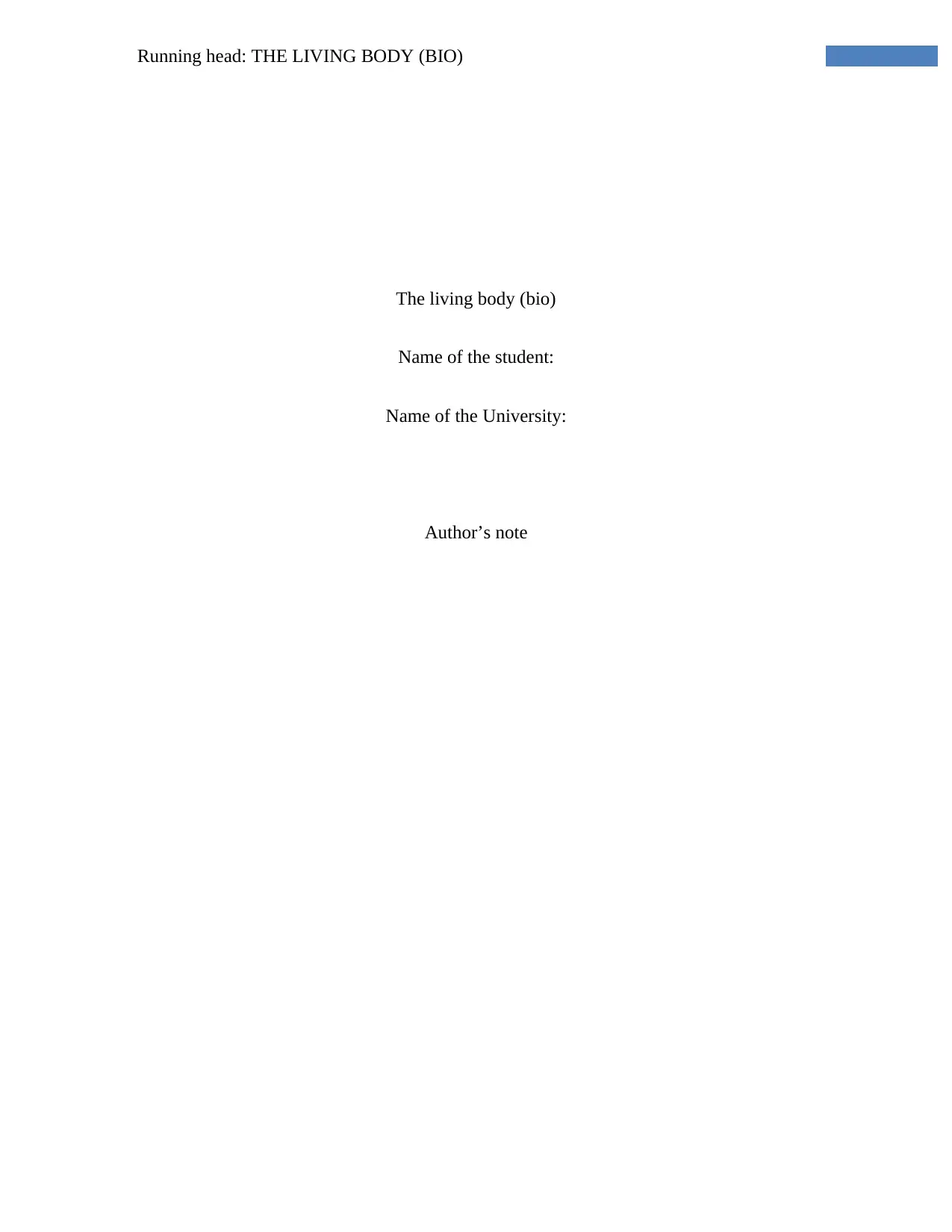
Running head: THE LIVING BODY (BIO)
The living body (bio)
Name of the student:
Name of the University:
Author’s note
The living body (bio)
Name of the student:
Name of the University:
Author’s note
Paraphrase This Document
Need a fresh take? Get an instant paraphrase of this document with our AI Paraphraser

1THE LIVING BODY (BIO)
Task 3:
Key components of the reflex arc:
Reflex arc is the neurological unit of a neuron that carriers nerve impulses to the spinal
cord in response to a stimulus. For example, when a person touches a hot object, the person
automatically pulls their hand without conscious effort. This action is a type of reflex action
which is governed by five parts of a reflex arc. The five key components of the reflex arc are as
follows:
Receptor: Receptor is the sense organ in skin, muscle or other organs that responds to a stimulus
or signals in the external/internal environment. There are different types of receptors that can
respond to pain, chemical stimuli or taste.
Sensory neuron: Sensory neuron is the part that contains sensory receptor and carries impulses
towards the central nervous system (CNS). The activated sensory neuron send the signals all the
way to the spinal cord.
Interneuron: It is the component that carries nerve impulse within CNS and connects or relays
signals to the next neuron called the motor neuron.
Motor neuron: It is the component that carries impulse away from the CNS to the body and
connect it with a muscle.
Effector: Effector is the structure or organ by which an animal or person responds to the stimulus
such as muscle and gland (Hantman and Kaltschmidt, 2016).
Task 3:
Key components of the reflex arc:
Reflex arc is the neurological unit of a neuron that carriers nerve impulses to the spinal
cord in response to a stimulus. For example, when a person touches a hot object, the person
automatically pulls their hand without conscious effort. This action is a type of reflex action
which is governed by five parts of a reflex arc. The five key components of the reflex arc are as
follows:
Receptor: Receptor is the sense organ in skin, muscle or other organs that responds to a stimulus
or signals in the external/internal environment. There are different types of receptors that can
respond to pain, chemical stimuli or taste.
Sensory neuron: Sensory neuron is the part that contains sensory receptor and carries impulses
towards the central nervous system (CNS). The activated sensory neuron send the signals all the
way to the spinal cord.
Interneuron: It is the component that carries nerve impulse within CNS and connects or relays
signals to the next neuron called the motor neuron.
Motor neuron: It is the component that carries impulse away from the CNS to the body and
connect it with a muscle.
Effector: Effector is the structure or organ by which an animal or person responds to the stimulus
such as muscle and gland (Hantman and Kaltschmidt, 2016).
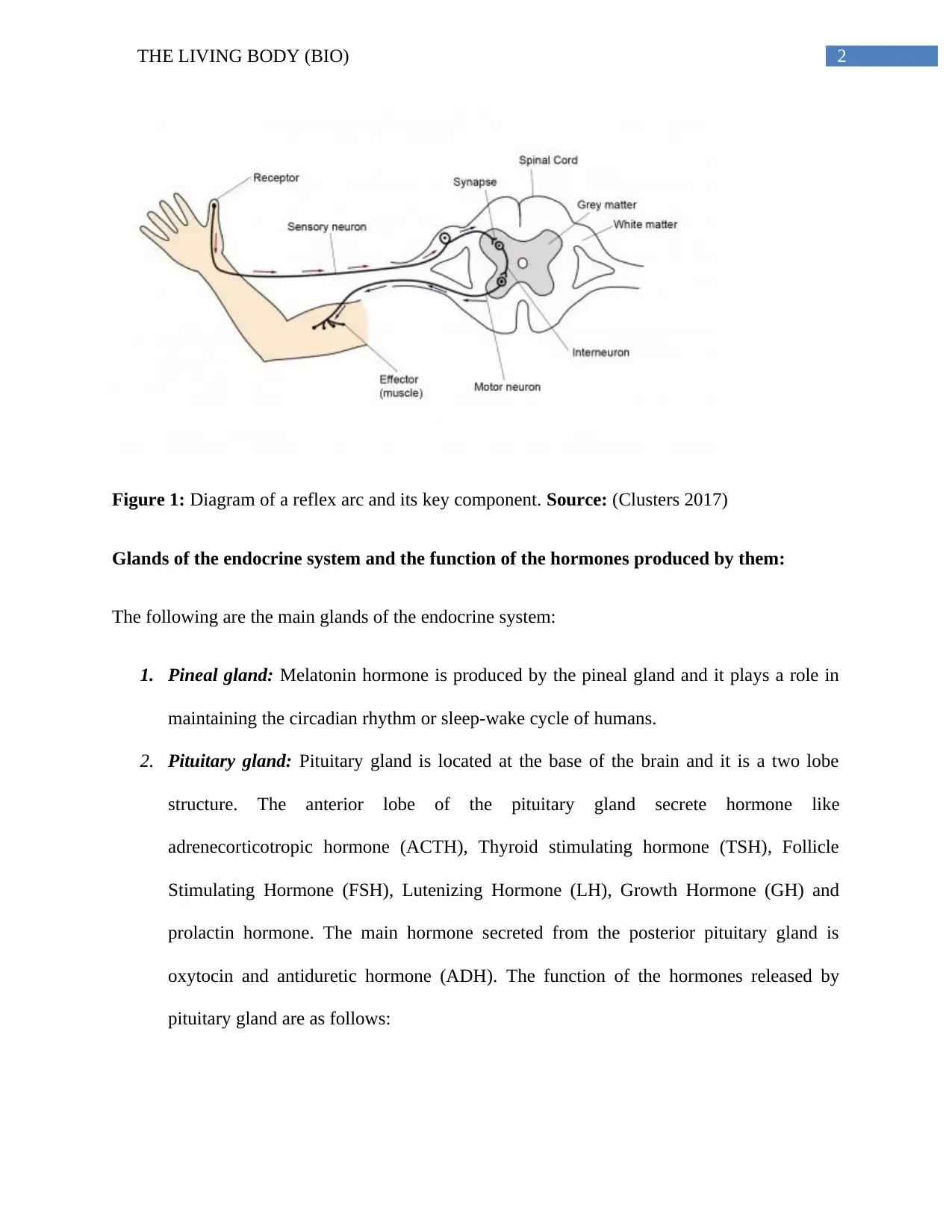
2THE LIVING BODY (BIO)
Figure 1: Diagram of a reflex arc and its key component. Source: (Clusters 2017)
Glands of the endocrine system and the function of the hormones produced by them:
The following are the main glands of the endocrine system:
1. Pineal gland: Melatonin hormone is produced by the pineal gland and it plays a role in
maintaining the circadian rhythm or sleep-wake cycle of humans.
2. Pituitary gland: Pituitary gland is located at the base of the brain and it is a two lobe
structure. The anterior lobe of the pituitary gland secrete hormone like
adrenecorticotropic hormone (ACTH), Thyroid stimulating hormone (TSH), Follicle
Stimulating Hormone (FSH), Lutenizing Hormone (LH), Growth Hormone (GH) and
prolactin hormone. The main hormone secreted from the posterior pituitary gland is
oxytocin and antiduretic hormone (ADH). The function of the hormones released by
pituitary gland are as follows:
Figure 1: Diagram of a reflex arc and its key component. Source: (Clusters 2017)
Glands of the endocrine system and the function of the hormones produced by them:
The following are the main glands of the endocrine system:
1. Pineal gland: Melatonin hormone is produced by the pineal gland and it plays a role in
maintaining the circadian rhythm or sleep-wake cycle of humans.
2. Pituitary gland: Pituitary gland is located at the base of the brain and it is a two lobe
structure. The anterior lobe of the pituitary gland secrete hormone like
adrenecorticotropic hormone (ACTH), Thyroid stimulating hormone (TSH), Follicle
Stimulating Hormone (FSH), Lutenizing Hormone (LH), Growth Hormone (GH) and
prolactin hormone. The main hormone secreted from the posterior pituitary gland is
oxytocin and antiduretic hormone (ADH). The function of the hormones released by
pituitary gland are as follows:
⊘ This is a preview!⊘
Do you want full access?
Subscribe today to unlock all pages.

Trusted by 1+ million students worldwide

3THE LIVING BODY (BIO)
ACTH- Its site of action is adrenal cortex and the main function is to stimulate the release of
cortisol.
TSH- It stimulates the release of thyroxine from the thyroid gland.
LH- In case of females, release of LH results in ovulation whereas in males, secretion of LH
results in testosterone production.
GH- It plays a role in stimulating body growth by stimulating the liver and other organs to
produce IGF-I or Insulin-like growth factors.
Prolactin- It is the hormone that promotes lactation and results in milk production.
ADH- ADH plays a role in the retention of water by causing the kidney to reabsorb solute-free
water and regulate the tonicity of body fluids.
Oxytocin- The oxytocin hormones has two functions. It stimulates contraction of the breast to
release milk and stimulates contraction of the uterus during labor (Musumeci et al. 2015).
3. Thyroid: T3 (Triodothyronine) and T4 (Thyroxine) are the main hormone secreted by
thyroid gland it plays a role in regulating body temperature and heart rate of an
individual. TSH hormones released from thyroid gland controls the secretion of these
hormones from the thyroid gland (Fancy, Gallagher III and Hornig 2010).
4. Parathyroid: The parathyroid gland releases parathyroid hormones when level of blood
calcium level in the blood decreases.
5. Adrenal gland: Three hormones released from adrenal gland included
mineralocorticoids, glucocorticoids and adrenal adrogens. Aldosterone is a type of
mineralocorticoid hormone and it plays a role in the regulation of blood pressure by
ACTH- Its site of action is adrenal cortex and the main function is to stimulate the release of
cortisol.
TSH- It stimulates the release of thyroxine from the thyroid gland.
LH- In case of females, release of LH results in ovulation whereas in males, secretion of LH
results in testosterone production.
GH- It plays a role in stimulating body growth by stimulating the liver and other organs to
produce IGF-I or Insulin-like growth factors.
Prolactin- It is the hormone that promotes lactation and results in milk production.
ADH- ADH plays a role in the retention of water by causing the kidney to reabsorb solute-free
water and regulate the tonicity of body fluids.
Oxytocin- The oxytocin hormones has two functions. It stimulates contraction of the breast to
release milk and stimulates contraction of the uterus during labor (Musumeci et al. 2015).
3. Thyroid: T3 (Triodothyronine) and T4 (Thyroxine) are the main hormone secreted by
thyroid gland it plays a role in regulating body temperature and heart rate of an
individual. TSH hormones released from thyroid gland controls the secretion of these
hormones from the thyroid gland (Fancy, Gallagher III and Hornig 2010).
4. Parathyroid: The parathyroid gland releases parathyroid hormones when level of blood
calcium level in the blood decreases.
5. Adrenal gland: Three hormones released from adrenal gland included
mineralocorticoids, glucocorticoids and adrenal adrogens. Aldosterone is a type of
mineralocorticoid hormone and it plays a role in the regulation of blood pressure by
Paraphrase This Document
Need a fresh take? Get an instant paraphrase of this document with our AI Paraphraser
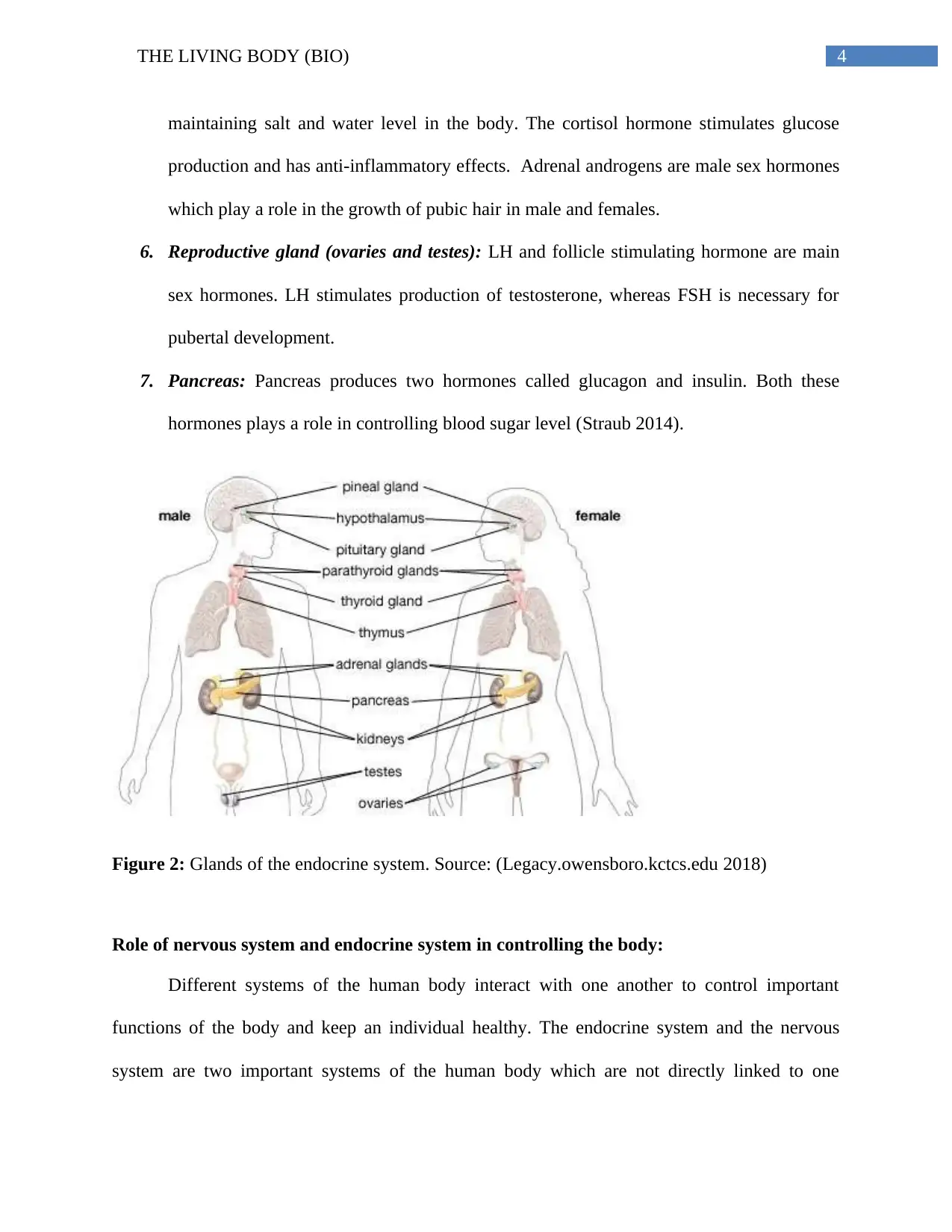
4THE LIVING BODY (BIO)
maintaining salt and water level in the body. The cortisol hormone stimulates glucose
production and has anti-inflammatory effects. Adrenal androgens are male sex hormones
which play a role in the growth of pubic hair in male and females.
6. Reproductive gland (ovaries and testes): LH and follicle stimulating hormone are main
sex hormones. LH stimulates production of testosterone, whereas FSH is necessary for
pubertal development.
7. Pancreas: Pancreas produces two hormones called glucagon and insulin. Both these
hormones plays a role in controlling blood sugar level (Straub 2014).
Figure 2: Glands of the endocrine system. Source: (Legacy.owensboro.kctcs.edu 2018)
Role of nervous system and endocrine system in controlling the body:
Different systems of the human body interact with one another to control important
functions of the body and keep an individual healthy. The endocrine system and the nervous
system are two important systems of the human body which are not directly linked to one
maintaining salt and water level in the body. The cortisol hormone stimulates glucose
production and has anti-inflammatory effects. Adrenal androgens are male sex hormones
which play a role in the growth of pubic hair in male and females.
6. Reproductive gland (ovaries and testes): LH and follicle stimulating hormone are main
sex hormones. LH stimulates production of testosterone, whereas FSH is necessary for
pubertal development.
7. Pancreas: Pancreas produces two hormones called glucagon and insulin. Both these
hormones plays a role in controlling blood sugar level (Straub 2014).
Figure 2: Glands of the endocrine system. Source: (Legacy.owensboro.kctcs.edu 2018)
Role of nervous system and endocrine system in controlling the body:
Different systems of the human body interact with one another to control important
functions of the body and keep an individual healthy. The endocrine system and the nervous
system are two important systems of the human body which are not directly linked to one
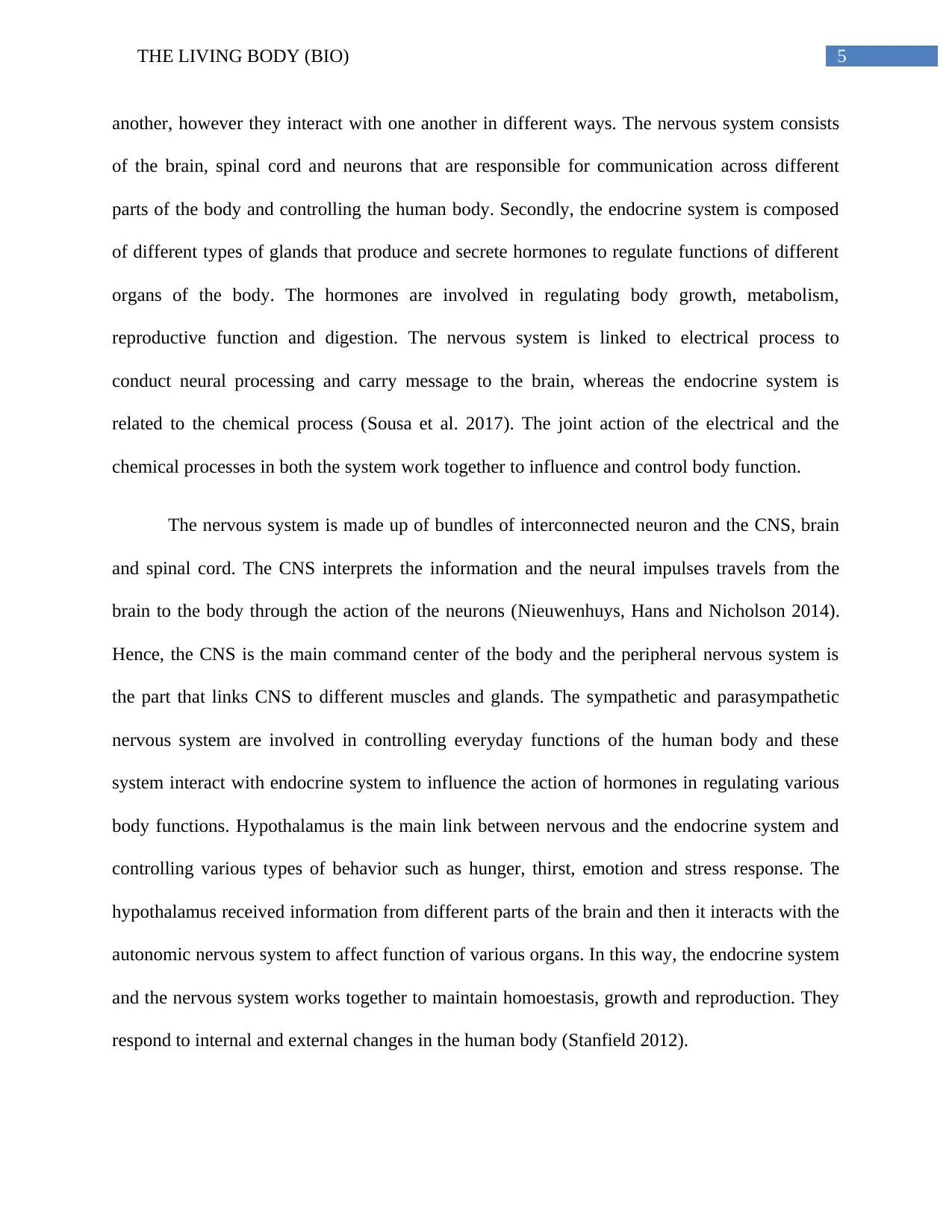
5THE LIVING BODY (BIO)
another, however they interact with one another in different ways. The nervous system consists
of the brain, spinal cord and neurons that are responsible for communication across different
parts of the body and controlling the human body. Secondly, the endocrine system is composed
of different types of glands that produce and secrete hormones to regulate functions of different
organs of the body. The hormones are involved in regulating body growth, metabolism,
reproductive function and digestion. The nervous system is linked to electrical process to
conduct neural processing and carry message to the brain, whereas the endocrine system is
related to the chemical process (Sousa et al. 2017). The joint action of the electrical and the
chemical processes in both the system work together to influence and control body function.
The nervous system is made up of bundles of interconnected neuron and the CNS, brain
and spinal cord. The CNS interprets the information and the neural impulses travels from the
brain to the body through the action of the neurons (Nieuwenhuys, Hans and Nicholson 2014).
Hence, the CNS is the main command center of the body and the peripheral nervous system is
the part that links CNS to different muscles and glands. The sympathetic and parasympathetic
nervous system are involved in controlling everyday functions of the human body and these
system interact with endocrine system to influence the action of hormones in regulating various
body functions. Hypothalamus is the main link between nervous and the endocrine system and
controlling various types of behavior such as hunger, thirst, emotion and stress response. The
hypothalamus received information from different parts of the brain and then it interacts with the
autonomic nervous system to affect function of various organs. In this way, the endocrine system
and the nervous system works together to maintain homoestasis, growth and reproduction. They
respond to internal and external changes in the human body (Stanfield 2012).
another, however they interact with one another in different ways. The nervous system consists
of the brain, spinal cord and neurons that are responsible for communication across different
parts of the body and controlling the human body. Secondly, the endocrine system is composed
of different types of glands that produce and secrete hormones to regulate functions of different
organs of the body. The hormones are involved in regulating body growth, metabolism,
reproductive function and digestion. The nervous system is linked to electrical process to
conduct neural processing and carry message to the brain, whereas the endocrine system is
related to the chemical process (Sousa et al. 2017). The joint action of the electrical and the
chemical processes in both the system work together to influence and control body function.
The nervous system is made up of bundles of interconnected neuron and the CNS, brain
and spinal cord. The CNS interprets the information and the neural impulses travels from the
brain to the body through the action of the neurons (Nieuwenhuys, Hans and Nicholson 2014).
Hence, the CNS is the main command center of the body and the peripheral nervous system is
the part that links CNS to different muscles and glands. The sympathetic and parasympathetic
nervous system are involved in controlling everyday functions of the human body and these
system interact with endocrine system to influence the action of hormones in regulating various
body functions. Hypothalamus is the main link between nervous and the endocrine system and
controlling various types of behavior such as hunger, thirst, emotion and stress response. The
hypothalamus received information from different parts of the brain and then it interacts with the
autonomic nervous system to affect function of various organs. In this way, the endocrine system
and the nervous system works together to maintain homoestasis, growth and reproduction. They
respond to internal and external changes in the human body (Stanfield 2012).
⊘ This is a preview!⊘
Do you want full access?
Subscribe today to unlock all pages.

Trusted by 1+ million students worldwide
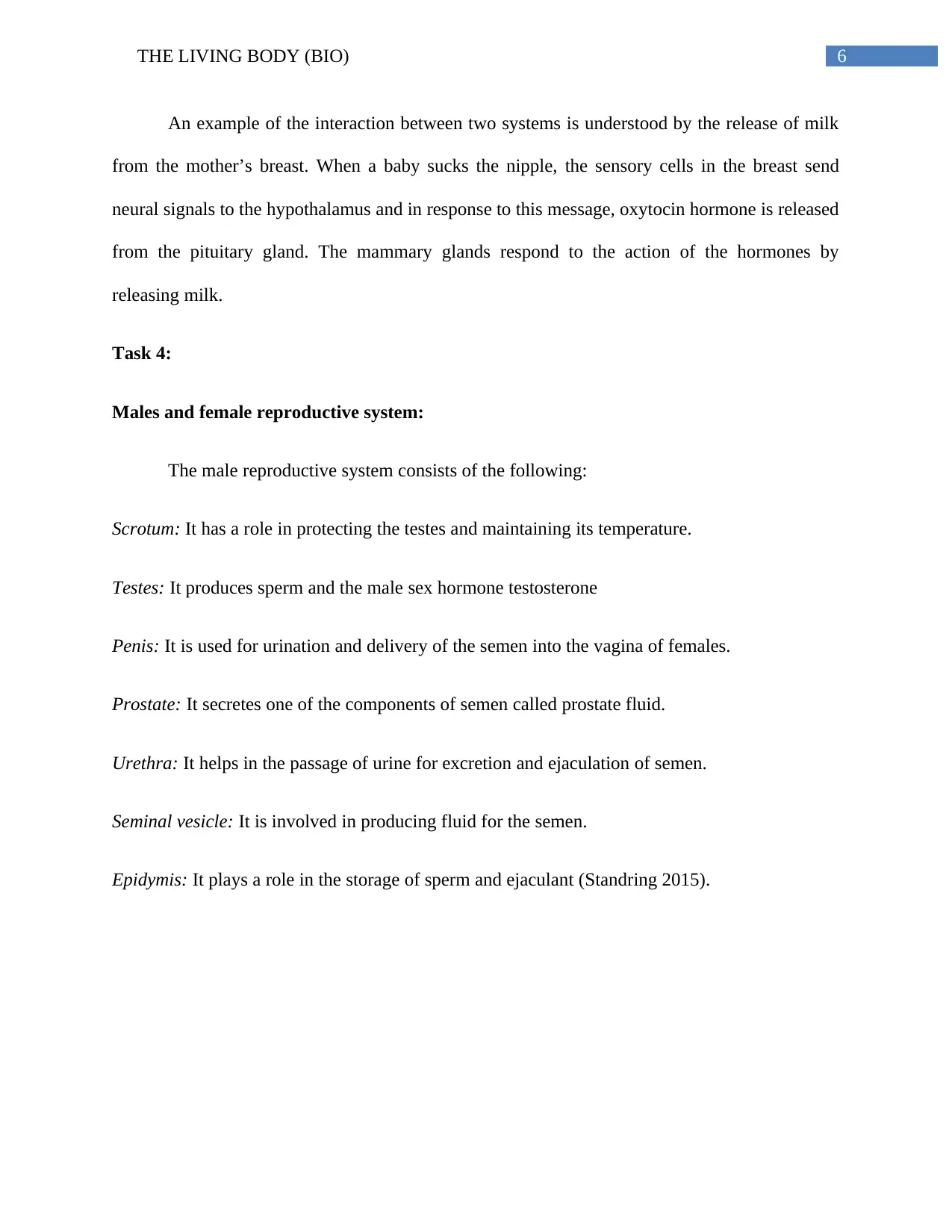
6THE LIVING BODY (BIO)
An example of the interaction between two systems is understood by the release of milk
from the mother’s breast. When a baby sucks the nipple, the sensory cells in the breast send
neural signals to the hypothalamus and in response to this message, oxytocin hormone is released
from the pituitary gland. The mammary glands respond to the action of the hormones by
releasing milk.
Task 4:
Males and female reproductive system:
The male reproductive system consists of the following:
Scrotum: It has a role in protecting the testes and maintaining its temperature.
Testes: It produces sperm and the male sex hormone testosterone
Penis: It is used for urination and delivery of the semen into the vagina of females.
Prostate: It secretes one of the components of semen called prostate fluid.
Urethra: It helps in the passage of urine for excretion and ejaculation of semen.
Seminal vesicle: It is involved in producing fluid for the semen.
Epidymis: It plays a role in the storage of sperm and ejaculant (Standring 2015).
An example of the interaction between two systems is understood by the release of milk
from the mother’s breast. When a baby sucks the nipple, the sensory cells in the breast send
neural signals to the hypothalamus and in response to this message, oxytocin hormone is released
from the pituitary gland. The mammary glands respond to the action of the hormones by
releasing milk.
Task 4:
Males and female reproductive system:
The male reproductive system consists of the following:
Scrotum: It has a role in protecting the testes and maintaining its temperature.
Testes: It produces sperm and the male sex hormone testosterone
Penis: It is used for urination and delivery of the semen into the vagina of females.
Prostate: It secretes one of the components of semen called prostate fluid.
Urethra: It helps in the passage of urine for excretion and ejaculation of semen.
Seminal vesicle: It is involved in producing fluid for the semen.
Epidymis: It plays a role in the storage of sperm and ejaculant (Standring 2015).
Paraphrase This Document
Need a fresh take? Get an instant paraphrase of this document with our AI Paraphraser
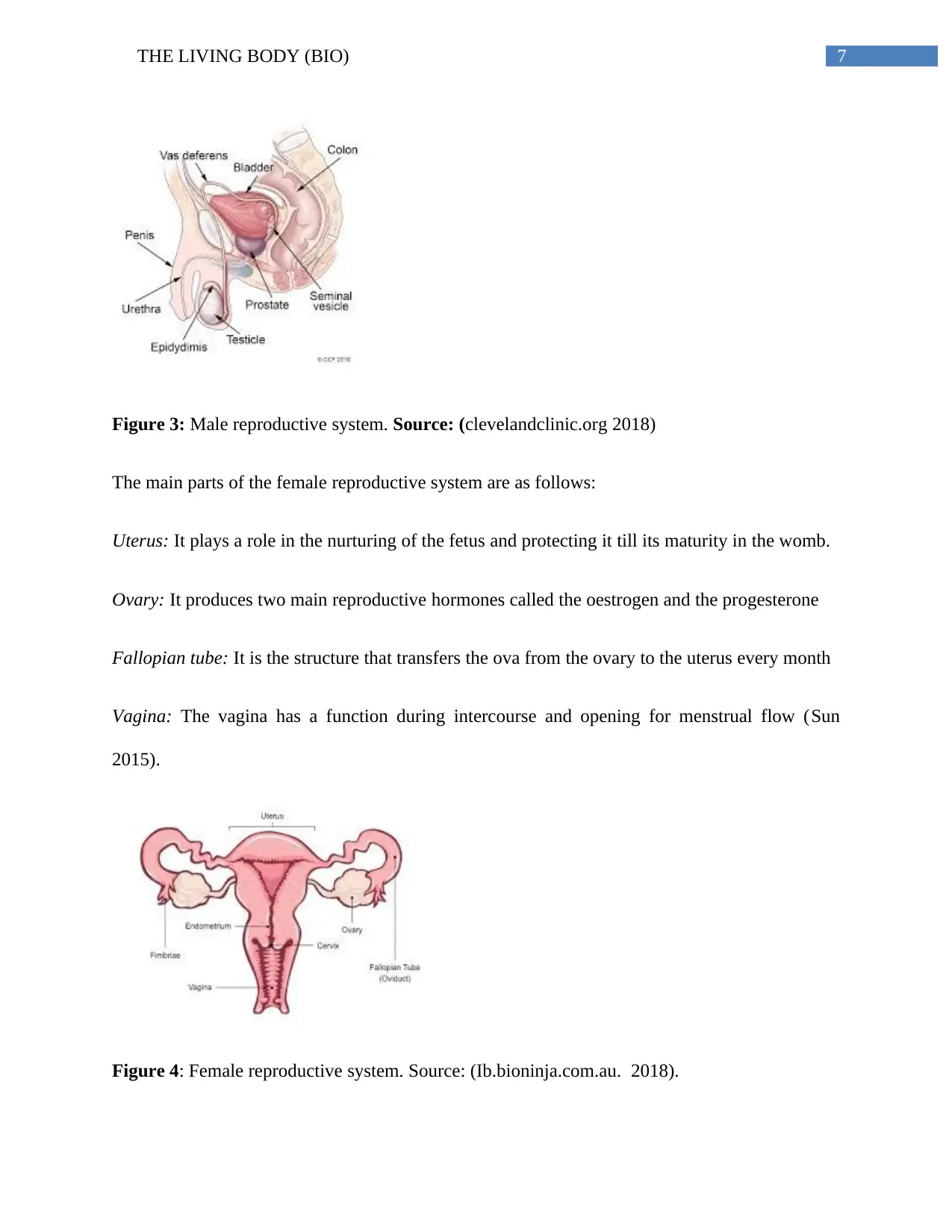
7THE LIVING BODY (BIO)
Figure 3: Male reproductive system. Source: (clevelandclinic.org 2018)
The main parts of the female reproductive system are as follows:
Uterus: It plays a role in the nurturing of the fetus and protecting it till its maturity in the womb.
Ovary: It produces two main reproductive hormones called the oestrogen and the progesterone
Fallopian tube: It is the structure that transfers the ova from the ovary to the uterus every month
Vagina: The vagina has a function during intercourse and opening for menstrual flow (Sun
2015).
Figure 4: Female reproductive system. Source: (Ib.bioninja.com.au. 2018).
Figure 3: Male reproductive system. Source: (clevelandclinic.org 2018)
The main parts of the female reproductive system are as follows:
Uterus: It plays a role in the nurturing of the fetus and protecting it till its maturity in the womb.
Ovary: It produces two main reproductive hormones called the oestrogen and the progesterone
Fallopian tube: It is the structure that transfers the ova from the ovary to the uterus every month
Vagina: The vagina has a function during intercourse and opening for menstrual flow (Sun
2015).
Figure 4: Female reproductive system. Source: (Ib.bioninja.com.au. 2018).

8THE LIVING BODY (BIO)
Reference:
clevelandclinic.org 2018. Male Reproductive System Information | Cleveland Clinic. Cleveland
Clinic. Retrieved 8 April 2018, from https://my.clevelandclinic.org/health/articles/9117-male-
reproductive-system
Clusters, C. 2017. Reflex Action and Reflex Arc: What Happens When You Accidentally Touch a
Hot Pot. Owlcation. Retrieved 7 April 2018, from https://owlcation.com/stem/Here-is-what-
happens-when-you-accidentally-touch-a-hot-pot
Fancy, T., Gallagher III, D. and Hornig, J.D., 2010. Surgical anatomy of the thyroid and
parathyroid glands. Otolaryngologic Clinics of North America, 43(2), pp.221-227.
Hantman, A.W. and Kaltschmidt, J.A., 2016. Satb2 Stations Neurons along Reflex
Arcs. Neuron, 91(4), pp.711-713.
Ib.bioninja.com.au. 2018. Female Reproductive System | BioNinja. Retrieved 8 April 2018,
from http://ib.bioninja.com.au/standard-level/topic-6-human-physiology/66-hormones-
homeostasis-and/female-reproductive-system.html
Legacy.owensboro.kctcs.edu. 2018. APII Notes. Retrieved 8 April 2018, from
https://legacy.owensboro.kctcs.edu/gcaplan/anat2/notes/APII%20Notes1%20endocrine.htm
Musumeci, G., Castorina, S., Castrogiovanni, P., Loreto, C., Leonardi, R., Aiello, F.C., Magro,
G. and Imbesi, R., 2015. A journey through the pituitary gland: Development, structure and
function, with emphasis on embryo-foetal and later development. Acta histochemica, 117(4-5),
pp.355-366.
Reference:
clevelandclinic.org 2018. Male Reproductive System Information | Cleveland Clinic. Cleveland
Clinic. Retrieved 8 April 2018, from https://my.clevelandclinic.org/health/articles/9117-male-
reproductive-system
Clusters, C. 2017. Reflex Action and Reflex Arc: What Happens When You Accidentally Touch a
Hot Pot. Owlcation. Retrieved 7 April 2018, from https://owlcation.com/stem/Here-is-what-
happens-when-you-accidentally-touch-a-hot-pot
Fancy, T., Gallagher III, D. and Hornig, J.D., 2010. Surgical anatomy of the thyroid and
parathyroid glands. Otolaryngologic Clinics of North America, 43(2), pp.221-227.
Hantman, A.W. and Kaltschmidt, J.A., 2016. Satb2 Stations Neurons along Reflex
Arcs. Neuron, 91(4), pp.711-713.
Ib.bioninja.com.au. 2018. Female Reproductive System | BioNinja. Retrieved 8 April 2018,
from http://ib.bioninja.com.au/standard-level/topic-6-human-physiology/66-hormones-
homeostasis-and/female-reproductive-system.html
Legacy.owensboro.kctcs.edu. 2018. APII Notes. Retrieved 8 April 2018, from
https://legacy.owensboro.kctcs.edu/gcaplan/anat2/notes/APII%20Notes1%20endocrine.htm
Musumeci, G., Castorina, S., Castrogiovanni, P., Loreto, C., Leonardi, R., Aiello, F.C., Magro,
G. and Imbesi, R., 2015. A journey through the pituitary gland: Development, structure and
function, with emphasis on embryo-foetal and later development. Acta histochemica, 117(4-5),
pp.355-366.
⊘ This is a preview!⊘
Do you want full access?
Subscribe today to unlock all pages.

Trusted by 1+ million students worldwide
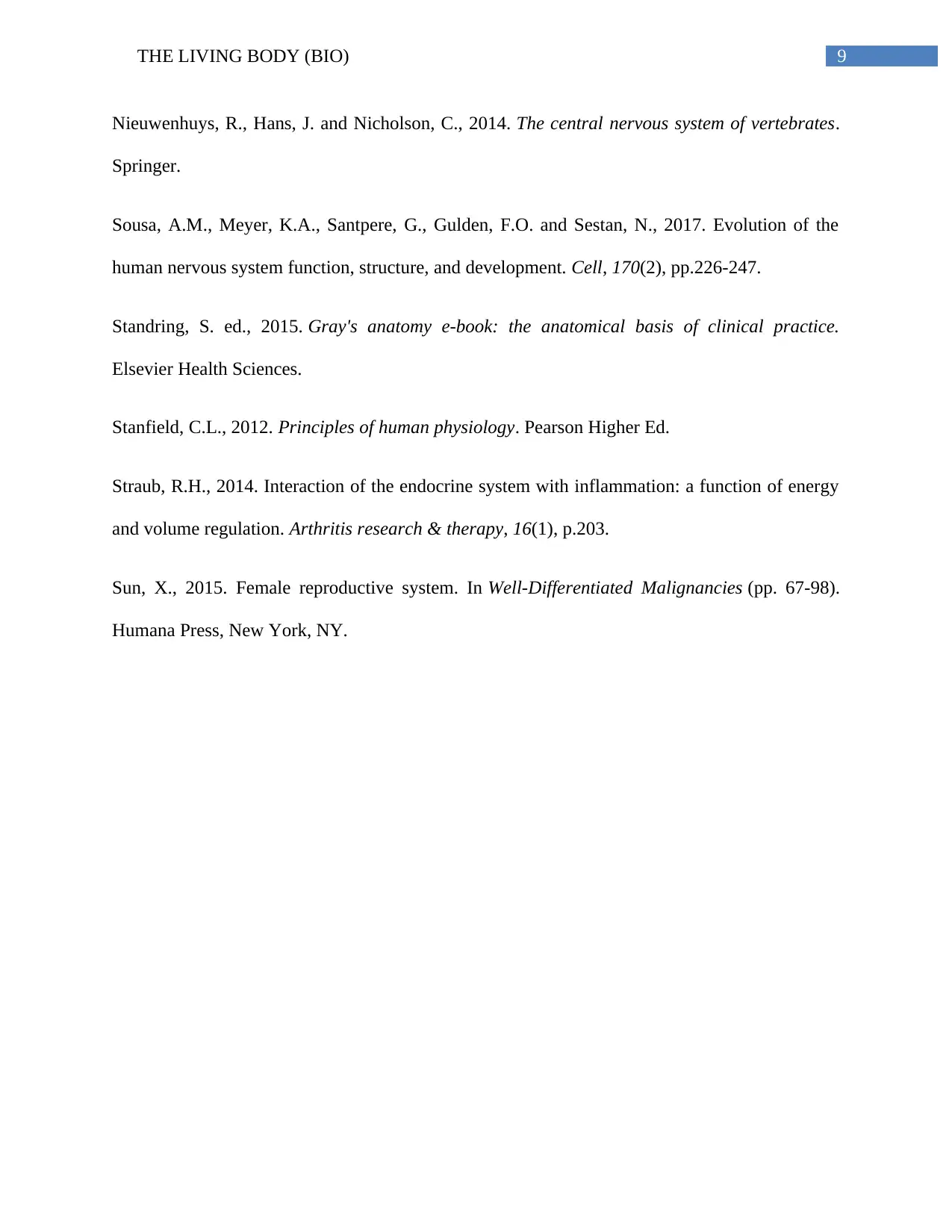
9THE LIVING BODY (BIO)
Nieuwenhuys, R., Hans, J. and Nicholson, C., 2014. The central nervous system of vertebrates.
Springer.
Sousa, A.M., Meyer, K.A., Santpere, G., Gulden, F.O. and Sestan, N., 2017. Evolution of the
human nervous system function, structure, and development. Cell, 170(2), pp.226-247.
Standring, S. ed., 2015. Gray's anatomy e-book: the anatomical basis of clinical practice.
Elsevier Health Sciences.
Stanfield, C.L., 2012. Principles of human physiology. Pearson Higher Ed.
Straub, R.H., 2014. Interaction of the endocrine system with inflammation: a function of energy
and volume regulation. Arthritis research & therapy, 16(1), p.203.
Sun, X., 2015. Female reproductive system. In Well-Differentiated Malignancies (pp. 67-98).
Humana Press, New York, NY.
Nieuwenhuys, R., Hans, J. and Nicholson, C., 2014. The central nervous system of vertebrates.
Springer.
Sousa, A.M., Meyer, K.A., Santpere, G., Gulden, F.O. and Sestan, N., 2017. Evolution of the
human nervous system function, structure, and development. Cell, 170(2), pp.226-247.
Standring, S. ed., 2015. Gray's anatomy e-book: the anatomical basis of clinical practice.
Elsevier Health Sciences.
Stanfield, C.L., 2012. Principles of human physiology. Pearson Higher Ed.
Straub, R.H., 2014. Interaction of the endocrine system with inflammation: a function of energy
and volume regulation. Arthritis research & therapy, 16(1), p.203.
Sun, X., 2015. Female reproductive system. In Well-Differentiated Malignancies (pp. 67-98).
Humana Press, New York, NY.
1 out of 10
Related Documents
Your All-in-One AI-Powered Toolkit for Academic Success.
+13062052269
info@desklib.com
Available 24*7 on WhatsApp / Email
![[object Object]](/_next/static/media/star-bottom.7253800d.svg)
Unlock your academic potential
Copyright © 2020–2026 A2Z Services. All Rights Reserved. Developed and managed by ZUCOL.





